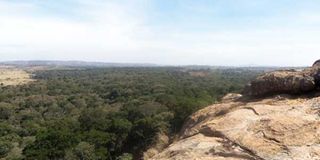In the steps of history

Kakamega Forest as seen from the top of Tabolwa Rock in North Nandi Forest. Photo: Mary Mbenge
What you need to know:
- Walk in the footsteps of our ancestors and experience breathtaking views on the rocks in North Nandi Forest
In the first light of dawn, the forest air is crisp. We’re in North Nandi Forest, taking a stroll down one of the many narrow paths sandwiched between giant trees and the thick lower canopy of shrubs, giant tree ferns by the streams and wild banana.
I’m tempted to pick the red cherry-like fruit from one of the shrubs but the general rule in forests is to keep your hands off things you don’t know – especially bright fruits and if there’s no one snacking on it, there may be a reason for it.
It is a busy early morning – as usual for the birds and other wildlife before the sun gets too hot. Suddenly Mary Mbenge, the Nature Kenya project officer based at Nandi stops in her tracks – she has spotted the Ugandan woodland warbler. The Ugandan woodland warbler is found in most countries along the equatorial forest belt of Africa like Cameroon, DRC, Uganda and Equatorial Guinea. It’s a lifer for me – that means first time seen in birding lingo.
It is also my first time in North Nandi Forest and I’m excited. Joel Kanda, the warden in charge of Nandi county at the Kenya Wildlife Service leads us to the edge of the forest boundary from where the hump of Mount Elgon appears in the distance.
Turning around, we head to Tabolwa Rock, making our way up the huge grey granite rocks. The panorama from this height is stunning. Again, Elgon appears in a haze in the horizon, Kakamega’s close canopy forest spreads below and closer on the boulder, Kanda points to the ‘footprints’ he’s been telling us about. “Look, they are like human footprints,” he points to one.
Curious, we explore the rock and discover more besides the ‘human’ footprints. There are what could be elephant footprints on granite, human child footsteps and even possibly those belonging to carnivores. It is amazing.
INTERESTING NATURAL FORMATIONS
The sun begins to warm us but the wind blows with a force whipped up from the forests and the rising hot air – and I stay clear from the very edge of the rock hill not wanting to be blown off it.
“Follow this way,” instructs Mary. “I’ll show you the woman and the map of Kenya on the rocks.” I’m expecting graffiti but it’s not. In place is a natural form of a well-endowed woman on the grey rocks as Mary points out. A few feet away on a steep incline is the map of Kenya complete with features like Lake Turkana, Mount Kenya and whatever else the eye can make out. And it’s a natural formation.
My imagination is going riot – I’m thinking of the 3.6 million-year-old Laetoli footprints of one of our ancestors, the Australopithecus afarensis. At the time of discovery in 1978 by Mary Leakey, the footprints were the earliest record of bipidelism in hominids.
I ask Kanda if there is any research showing that early hominids could possibly have wandered around here. He knows of none.
I’m taken aback. The first scientific research in North Nandi Forest was done in the late 1970s when the forestry department under the Ministry of Natural Resources wanted to hive a huge chunk of it to make way for a soft-wood plantation.
A joint research was undertaken by the National Museums of Kenya and researchers from the Museum of Natural History Vienna to survey the flora and fauna of the forest in order to make proposals to protect the forest.
Since birds are great indicators of landscape studies, the lead authors of the research H. Schifter & G.R. Cunningham-van Someren recorded 117 bird species in the forest. What they found is that the distinctive subspecies of birds seen only in North Nandi Forest point to one important fact – that the separation of North Nandi and Kakamega forests happened eons ago to produce the signature species.
EXPLORING NORTH NANDI
North Nandi lies along the spine and west side of the Nandi escarpment. It is close to Kapsabet. The forest spans 32 kilometres in length and roughly nine kilometres in width. It is also the watershed for the Yala River, which flows westwards through Kakamega Forest to Lake Victoria.
There are many places of interest around Nandi Forest: University of Eastern Africa Baraton which houses a snake museum with species from the surrounding forest. (But don’t go on a Saturday because it is closed); Kingwal swamp, where you can see a semi-aquatic rare antelope called the sitatunga, Rondo Retreat (prior booking a must) in Kakamega forest, South Nandi Forest, Nandi Rock, Bonjoge National Reserve and more.
Contact Nature Kenya Nandi Landscape office for local guides or for a place to camp or for cottages. Write to Mary Mbenge on [email protected] or Gibson Kitsao [email protected] or log on to www.naturekenya.org. You can also email Joel Kanda, a warden in Nandi County on [email protected].
For accommodation at Kapsabet, check in at Eden Springs Hotel, Kapsabet’s only up-market hotel complete with a gym, swimming pool and spacious grounds – www.edenspingshotel.com. If you are on a tight budget try Nandi Cottages and for inexpensive but great culinary delights try Stevenice hotel.




